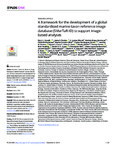A framework for the development of a global standardised marine taxon reference image database (SMarTaR-ID) to support image-based analyses
| dc.contributor.author | Howell, Kerry | |
| dc.contributor.author | Davies, JS | |
| dc.contributor.author | Allcock, AL | |
| dc.contributor.author | Braga-Henriques, A | |
| dc.contributor.author | Buhl-Mortensen, P | |
| dc.contributor.author | Carreiro-Silva, M | |
| dc.contributor.author | Dominguez-Carrió, C | |
| dc.contributor.author | Durden, JM | |
| dc.contributor.author | Foster, Nicola | |
| dc.contributor.author | Game, CA | |
| dc.contributor.author | Hitchin, B | |
| dc.contributor.author | Horton, T | |
| dc.contributor.author | Hosking, B | |
| dc.contributor.author | Jones, DOB | |
| dc.contributor.author | Mah, C | |
| dc.contributor.author | Laguionie Marchais, C | |
| dc.contributor.author | Menot, L | |
| dc.contributor.author | Morato, T | |
| dc.contributor.author | Pearman, TRR | |
| dc.contributor.author | Piechaud, Nils | |
| dc.contributor.author | Ross, RE | |
| dc.contributor.author | Ruhl, HA | |
| dc.contributor.author | Saeedi, H | |
| dc.contributor.author | Stefanoudis, PV | |
| dc.contributor.author | Taranto, GH | |
| dc.contributor.author | Thompson, MB | |
| dc.contributor.author | Taylor, JR | |
| dc.contributor.author | Tyler, P | |
| dc.contributor.author | Vad, J | |
| dc.contributor.author | Victorero, L | |
| dc.contributor.author | Vieira, RP | |
| dc.contributor.author | Woodall, LC | |
| dc.contributor.author | Xavier, JR | |
| dc.contributor.author | Wagner, D | |
| dc.date.accessioned | 2020-01-15T11:15:40Z | |
| dc.date.issued | 2019-12-31 | |
| dc.identifier.issn | 1932-6203 | |
| dc.identifier.issn | 1932-6203 | |
| dc.identifier.other | ARTN e0218904 | |
| dc.identifier.uri | http://hdl.handle.net/10026.1/15313 | |
| dc.description.abstract |
Video and image data are regularly used in the field of benthic ecology to document biodiversity. However, their use is subject to a number of challenges, principally the identification of taxa within the images without associated physical specimens. The challenge of applying traditional taxonomic keys to the identification of fauna from images has led to the development of personal, group, or institution level reference image catalogues of operational taxonomic units (OTUs) or morphospecies. Lack of standardisation among these reference catalogues has led to problems with observer bias and the inability to combine datasets across studies. In addition, lack of a common reference standard is stifling efforts in the application of artificial intelligence to taxon identification. Using the North Atlantic deep sea as a case study, we propose a database structure to facilitate standardisation of morphospecies image catalogues between research groups and support future use in multiple front-end applications. We also propose a framework for coordination of international efforts to develop reference guides for the identification of marine species from images. The proposed structure maps to the Darwin Core standard to allow integration with existing databases. We suggest a management framework where high-level taxonomic groups are curated by a regional team, consisting of both end users and taxonomic experts. We identify a mechanism by which overall quality of data within a common reference guide could be raised over the next decade. Finally, we discuss the role of a common reference standard in advancing marine ecology and supporting sustainable use of this ecosystem. | |
| dc.format.extent | e0218904-e0218904 | |
| dc.format.medium | Electronic-eCollection | |
| dc.language | en | |
| dc.language.iso | en | |
| dc.publisher | Public Library of Science (PLoS) | |
| dc.subject | Animals | |
| dc.subject | Artificial Intelligence | |
| dc.subject | Biodiversity | |
| dc.subject | Classification | |
| dc.subject | Data Curation | |
| dc.subject | Databases, Factual | |
| dc.subject | Ecology | |
| dc.subject | Ecosystem | |
| dc.subject | Image Processing, Computer-Assisted | |
| dc.subject | Marine Biology | |
| dc.title | A framework for the development of a global standardised marine taxon reference image database (SMarTaR-ID) to support image-based analyses | |
| dc.type | journal-article | |
| dc.type | Journal Article | |
| dc.type | Research Support, Non-U.S. Gov't | |
| dc.type | Research Support, U.S. Gov't, Non-P.H.S. | |
| plymouth.author-url | https://www.webofscience.com/api/gateway?GWVersion=2&SrcApp=PARTNER_APP&SrcAuth=LinksAMR&KeyUT=WOS:000515096600003&DestLinkType=FullRecord&DestApp=ALL_WOS&UsrCustomerID=11bb513d99f797142bcfeffcc58ea008 | |
| plymouth.issue | 12 | |
| plymouth.volume | 14 | |
| plymouth.publication-status | Published online | |
| plymouth.journal | PLOS ONE | |
| dc.identifier.doi | 10.1371/journal.pone.0218904 | |
| plymouth.organisational-group | /Plymouth | |
| plymouth.organisational-group | /Plymouth/Faculty of Science and Engineering | |
| plymouth.organisational-group | /Plymouth/Faculty of Science and Engineering/School of Biological and Marine Sciences | |
| plymouth.organisational-group | /Plymouth/REF 2021 Researchers by UoA | |
| plymouth.organisational-group | /Plymouth/REF 2021 Researchers by UoA/UoA07 Earth Systems and Environmental Sciences | |
| plymouth.organisational-group | /Plymouth/Research Groups | |
| plymouth.organisational-group | /Plymouth/Research Groups/Marine Institute | |
| plymouth.organisational-group | /Plymouth/Users by role | |
| plymouth.organisational-group | /Plymouth/Users by role/Academics | |
| plymouth.organisational-group | /Plymouth/Users by role/Researchers in ResearchFish submission | |
| dc.publisher.place | United States | |
| dcterms.dateAccepted | 2019-12-09 | |
| dc.rights.embargodate | 2020-1-17 | |
| dc.identifier.eissn | 1932-6203 | |
| dc.rights.embargoperiod | Not known | |
| rioxxterms.versionofrecord | 10.1371/journal.pone.0218904 | |
| rioxxterms.licenseref.uri | http://www.rioxx.net/licenses/all-rights-reserved | |
| rioxxterms.type | Journal Article/Review | |
| plymouth.funder | Influence of population connectivity on depth-dependent diversity of deep-sea marine benthic biota::NERC |


